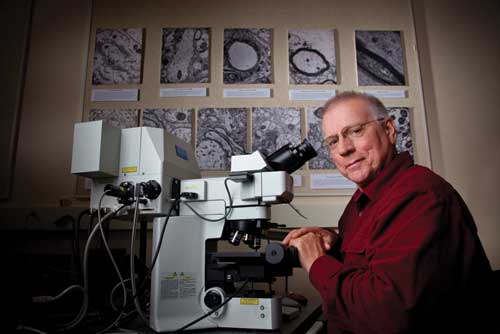The human brain is a remarkable organ. From the day we're born until the day we die, our brains evolve as we experience the world and expand our knowledge.
But the brain is also vulnerable to dementia-related diseases like Alzheimer's disease, which kills the brain's cerebral cortex cells and erodes short-term memory.

This summer, Canadian Centre for Behavioural Neuroscience (CCBN) neuroscientist Dr. Robert Sutherland made international headlines when he and his research team became the first in the world to regenerate cerebral cortex brain cells in adult rats.
The research focused on a part of the brain called the hippocampus, a seahorse-shaped region of the brain responsible for short- and long-term memory storage and retrieval. This is an area that is especially sensitive to illnesses or injuries that can create memory loss, explains Sutherland. It's also a part of the brain that throughout adult life spontaneously creates new cells that are able to easily find their correct position in the brain's circuitry.
The team began by killing off about half of these cells by depriving them of corticosterone, an important hormone the cells need to function, causing the rats to develop memory issues very similar to humans suffering with dementia. Through a combination of a specific protein therapy, an enriched living environment and exercise, the researchers were able to re-grow the lost brain cells and prove that the rats had regained their memory function.
Regenerating brain cells is a problem neuroscientists have been struggling with for many years, with limited success. The challenge stems from the nature of the brain itself. "If you open up a laptop and take a look at the circuit board, every portion you look at has a sophisticated set of connections with other pieces," says Sutherland. "The brain is even more complicated."
Sutherland and his team at the U of L's CCBN – including undergraduate and graduate students, post-doctoral trainee Jen Lai and doctoral candidates Simon Spanswick and Fraser Sparks – began working on the problem about five years ago.
Sutherland's history at the U of L goes back to 1980, when he completed post-doctoral training in neuropsychology and became a psychology faculty member until 1991. After a decade teaching and researching at the University of New Mexico, he returned to the U of L to help launch the CCBN, Canada's first department of neuroscience, in 2001.
Sutherland says the facility offers excellent infrastructure (including high-tech lab space and funding), and a critical mass of expertise. "It's a highly collaborative place. I've worked and published with virtually every faculty member," he says.
The CCBN is also an important training ground for up-and-coming neuroscientists, like doctoral candidate Fraser Sparks, who helped with the brain cell regeneration project. Sparks says Sutherland's lab has a unique research environment, encouraging students to assist on each other's research programs and allowing them the chance to explore anything they find intriguing. "One thing we're not afraid to do in the Sutherland lab is criticize theories – including our own," says Sparks.
While Sutherland's regeneration technique is a major discovery, it is only the beginning. The next step will be to translate the research into therapies that work for patients. Sutherland and his team have received a second five-year grant from the Canadian Institutes of Health Research (CIHR) to continue the project.
"Part of what we're doing is refining the treatments to get closer to an actual effective clinical therapy, and in an absolutely convincing manner, show that these cells are functioning the way they should," says Sutherland.
For patients with dementia diseases, a clinical therapy is desperately needed. Sutherland points out that at the current rate of growth, in 30 years, someone will develop dementia every two minutes.
"The total cost of dementia could reach $153 billion per year by 2038, up from the current cost of $15 billion per year. Without fundamental scientific advances such as ours, it is certain that the burdens will grow dramatically," says Sutherland. "It is urgent that we find ways of preventing, reversing and repairing injured brains. Our findings are a significant advance in that direction."
This story originally appeared in the Fall 2010 issue of SAM. For a look at the full issue of SAM in a flipbook format, follow this link.
